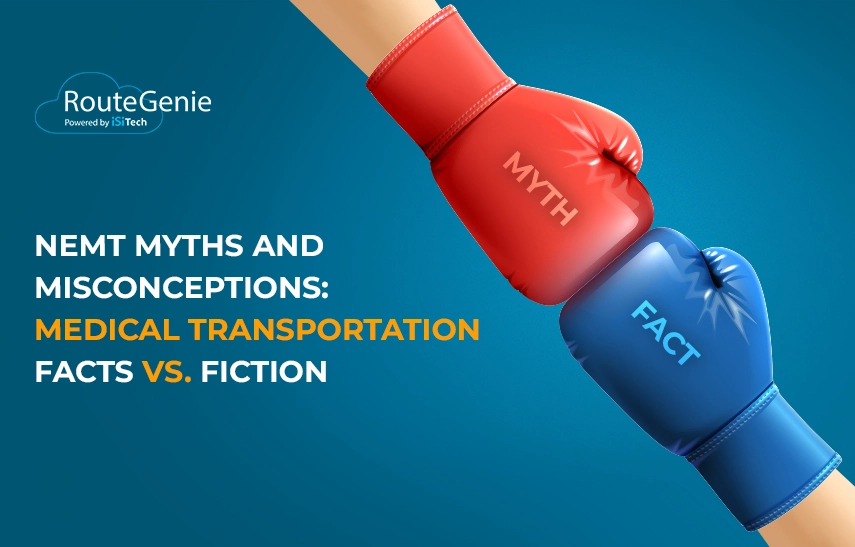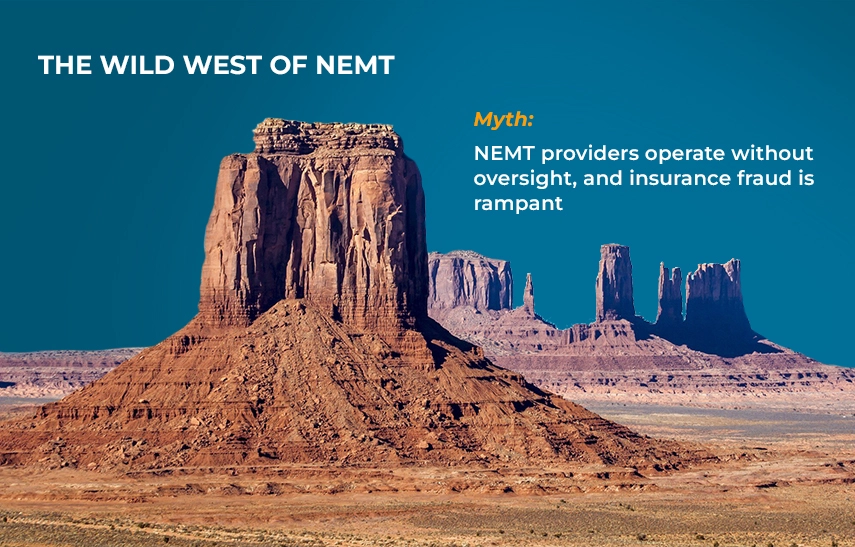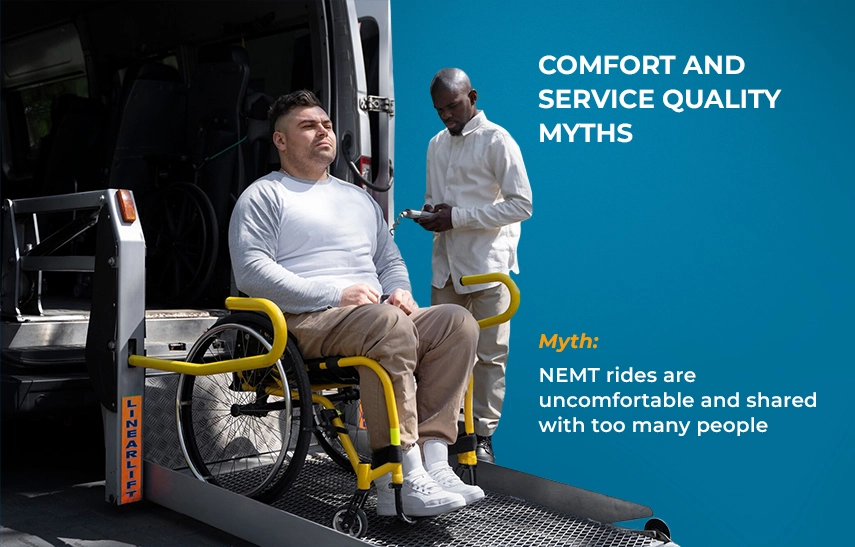NEMT Myths and Misconceptions: Medical Transportation Facts vs. Fiction

Despite diligently serving the American population since the 1960s, the NEMT (Non-emergency medical transportation) industry remains deeply misunderstood. The lack of public awareness generates numerous stereotypes and misconceptions that prevent entrepreneurs from entering this vibrant industry, while eligible passengers cannot fully benefit from this life-altering service. In this article, we will dispel the most common myths regarding the non-emergency medical transportation industry, both as a business and as a service.
Contents:
- NEMT as a Business: Truths You Need to Know to Run a Medical Transportation Company
- NEMT as a Service: Myths vs. Reality
- Conclusion
NEMT as a Business: Truths You Need to Know to Run a Medical Transportation Company
To finally set the record straight between the facts and fiction of NEMT as a business, we will have to address the most common beliefs held by people who are not deeply integrated into this trade.
NEMT Business Startup Myths
“You do not need experience in NEMT industry, and anyone with a car can start offering NEMT rides.”
Interestingly, the first part of this myth is actually true. The NEMT industry experience can definitely help you grow faster and avoid making rookie mistakes, but it is not required to start a medical transportation company. However, NEMT is not Uber or Lyft; not every person owning a car can provide this service. Drivers, vehicles, and companies must be licensed, insured, and compliant with safety, privacy, and medical transport standards. If billing Medicaid, they must also be enrolled in this program.
You cannot start an NEMT company with a single van and need significant funding.”
A quick search on the amount of money needed to start a non-emergency medical transportation company suggests that you will need at least $100,000. This number is misleading because you can start with a single van; in this case, the initial investment can be as low as $5,000. You probably won’t land big contracts with brokers, but private-pay customers can definitely fuel your enterprise until you are ready to scale up.
“NEMT business is a money hack to get rich fast.”
Unfortunately, this is far from reality. NEMT providers operate under strict regulations and often with tight margins. The rates can be low, while the business has to face extra costs such as ADA-compliant vehicles, liability insurance, driver training, deadhead miles, and compliance audits. In this environment, growing and remaining profitable can be difficult, as in any other business.
Vehicle and Driver Myths in NEMT
“NEMT vehicles are just regular cars with company logos. They're unsafe and poorly maintained.”
While ambulatory NEMT service can be performed by a regular passenger vehicle, most NEMT fleets are comprised of ADA-compliant vans. These are equipped with lifts, wheelchair restraints, gurneys, and first-aid kits. To maintain uninterrupted service delivery, vehicles undergo regular maintenance and safety inspections per state and federal mandates
“NEMT drivers do not need additional training or qualifications and are poorly paid.”
The requirements for an NEMT driver differ depending on the jurisdiction of operation. But it is worth noting that the majority of states require NEMT drivers to undergo background checks, regular drug testing, CPR/First Aid certificatioan, HIPAA training, and vehicle operation instruction.
The abovementioned requirements far exceed those for rideshare or taxi drivers, so NEMT companies have to offer competitive pay, bonuses, and benefits to attract and retain qualified professionals.
Regulation and Oversight Myths
 “NEMT providers operate without oversight, and insurance fraud is rampant.”
“NEMT providers operate without oversight, and insurance fraud is rampant.”
There is no denying that fraud in NEMT exists, but recent changes to the Medicaid policies require providers to follow strict documentation and compliance protocols, which entail the use of fraud prevention technologies like GPS verification and digital logs; plus, providers and brokers frequently go through audits and inspections.
“Working with transportation brokers is not profitable.”
On one hand, it is true that by signing up with NEMT brokers, you will lose some autonomy in terms of conducting your business. On the other hand, cooperation with brokers can be extremely lucrative, and given that the majority of states already use or are steadily transitioning to broker models, this is a clear path for scaling one’s medical transportation enterprise.
Technology and Innovation Myths
“Rideshare apps like Uber or Lyft will completely replace NEMT.”
Rideshare apps have deep penetration into our lives, but traditional vehicles used in the taxi service are not equipped for passengers with mobility issues or medical conditions. Rideshare services can assist with the ambulatory NEMT, and there might be a time when they will greatly complement the medical transportation, but at this point, MCOs and brokers mostly deny their use.
“NEMT software is not needed to run an NEMT business.”
Well, no one can stop you from running your operations manually using pen and paper scheduling, dispatching, and billing techniques. However, to stay competitive and effectively grow your fleet, you will need to implement an advanced software platform like RouteGenie. Moreover, more and more MCOs require the use of NEMT software for compliance.
"Value-based service model is less profitable than a volume-based one."
The latest NEMT trends suggest that it might be more profitable to apply the value-based NEMT model while streamlining your processes and reducing the overhead. In this new framework, providers get predictable revenue, passengers are expected to achieve better health outcomes, while the MCOs can save on the reduction of missed medical appointments and hospital readmissions.
NEMT as a Service: Myths vs. Reality
Just like NEMT is misunderstood by beginner entrepreneurs, many of its aspects remain a mystery to the public. In this section, we’ll separate fact from fiction and provide clarity on what NEMT really offers to passengers, their families, and communities.
Who and How People Can Use NEMT? Access and Eligibility Myths
“NEMT is only for low-income elderly people with disabilities who are on Medicaid.”
It is true that Medicaid is the major payer for NEMT, and, statistically speaking, the elderly population with disabilities is the main beneficiary of the service. However, there are no limitations for the use of NEMT regarding age, disability status, and insurance type. People of all ages, including those suffering from temporary or chronic conditions, can resort to the use of non-emergency medical transport. If they are not on Medicaid, then personal insurance or private-pay methods are also applicable.
“You can only use NEMT for emergencies and hospital visits.”
By definition, NEMT is a non-emergency service; therefore, it is not an ambulance and only covers scheduled trips to a hospital to undergo surgeries, routine care like dialysis, therapy, primary care, and mental health visits. It’s designed to support preventive and ongoing treatment, not emergencies.
“NEMT can be used for grocery trips or social visits.”
Unfortunately, this one is not true. Non-emergency medical transportation service is strictly limited to medical purposes. This does include doctor’s visits, a trip to a pharmacy, or even a medical equipment supplier, but social, recreational, or personal errands are excluded.
Comfort and Service Quality Myths

“NEMT rides are uncomfortable and shared with too many people.”
While shared rides improve efficiency and savings for the Medicaid program, most providers usually offer solo transportation when medically necessary or requested in advance. Policies vary by provider, but passenger safety and comfort are prioritized. The NEMT vehicles equipped according to the ADA standards can accommodate people with limited mobility, while the drivers are additionally trained in sensitivity, passenger care, and disability etiquette.
“NEMT is always unreliable and makes passengers late.”
On-time performance across the NEMT industry is often better than public transit and comparable to ridesharing during peak hours. In fact, providers use GPS, automated dispatch, and route optimization to improve timeliness. They also often work directly with medical facilities and Electronic Health Records (EHRs) to streamline discharge planning and reduce delays.
“Booking NEMT is complicated and time-consuming.”
Booking an NEMT ride has never been easier; many companies now offer mobile passenger apps, online portals, and centralized call centers for easy booking, which is on par with ordering a taxi.
“NEMT only operates in large cities,” or “Rural and urban individuals with medical needs have the same access to NEMT.”
States are required to offer statewide Medicaid NEMT coverage; therefore, rural areas also must be covered by this service. However, rural passengers often face fewer provider options and longer wait or ride times. They have to rely on creative solutions such as volunteer drivers, regional brokers, or hybrid NEMT–rideshare partnerships.
Financial Impact and Value Myths
“Insurance never covers NEMT services. You have to pay out-of-pocket every time.”
Medicaid is federally required to cover NEMT, and many Medicare Advantage, employer-sponsored, and private insurance plans offer benefits, too. Eligibility and documentation requirements vary, but full out-of-pocket cost is rarely the only option.
“NEMT is too expensive and not worth the taxpayer’s money.”
NEMT reduces long-term healthcare costs by preventing missed appointments, ER visits, and hospital readmissions. Studies show that NEMT provides a significant return on investment (ROI). Estimates indicate that for every $1 spent, Medicaid saves between $3 and $11 in avoided emergency room visits and hospital admissions.
Conclusion
NEMT is a critical but often misunderstood part of the healthcare system. Common misconceptions about its operational realities, cost, accessibility, and reliability can prevent patients from using it and entrepreneurs from entering the field. In reality, NEMT powered by advanced software, is a regulated, cost-effective service that helps reduce missed appointments and improve health outcomes. By understanding the facts, we can better support an industry that serves as a vital link between patients and the care they need.
About the author

As RouteGenie's Marketing Director, Yurii gained deep knowledge in the NEMT industry. He is an expert in marketing, utilizing all marketing channels to build RouteGenie's brand and to make sure NEMT providers have access to powerful NEMT software that can boost their growth. Yurii shares his knowledge by writing content on topics related to marketing, and the healthcare industry: medical transportation, home care, and medical billing.
The author assumes no responsibility or liability for any errors or omissions in the content of this site. The information contained in this site is provided on an "as is" basis with no guarantees of completeness, accuracy, usefulness or timeliness.